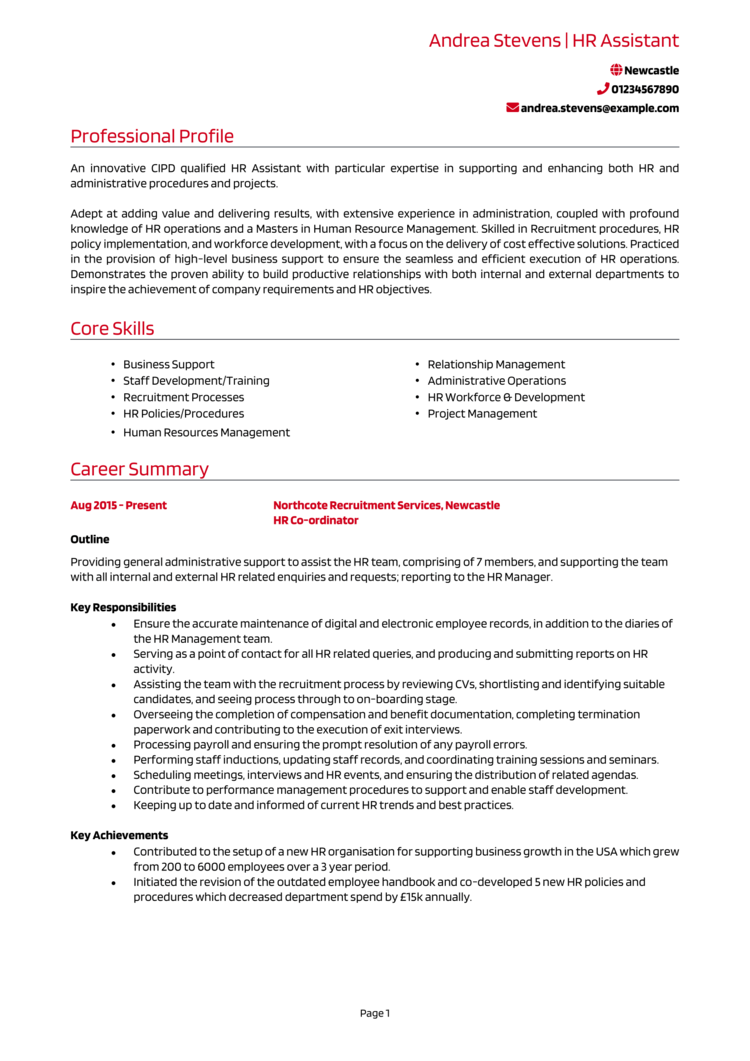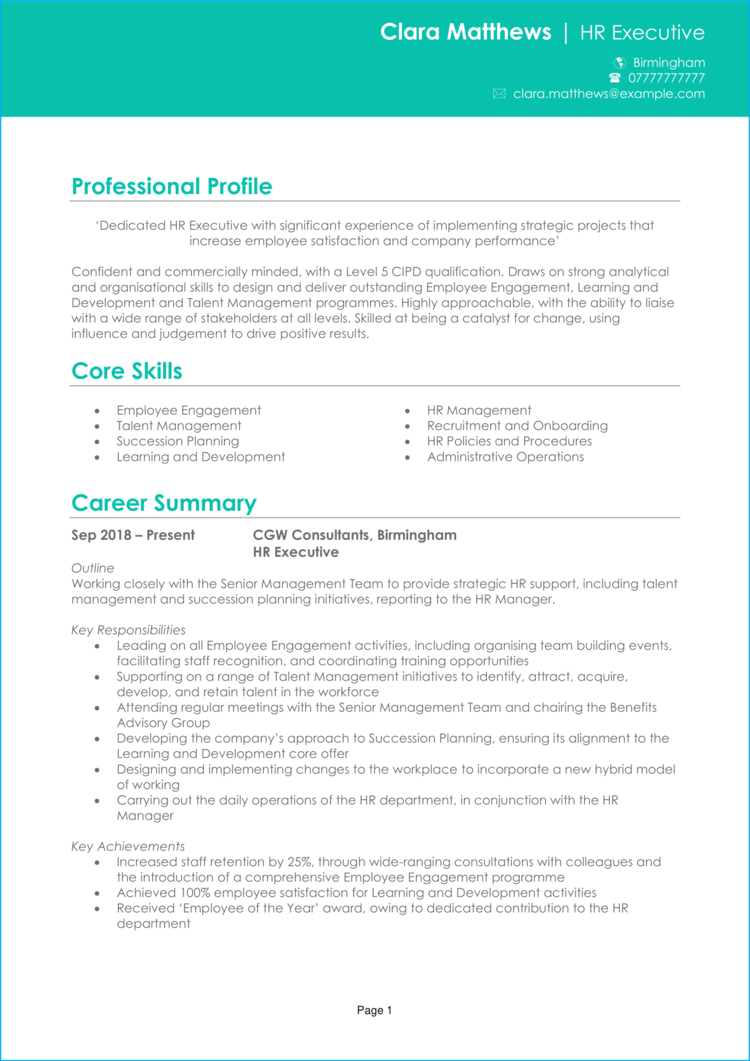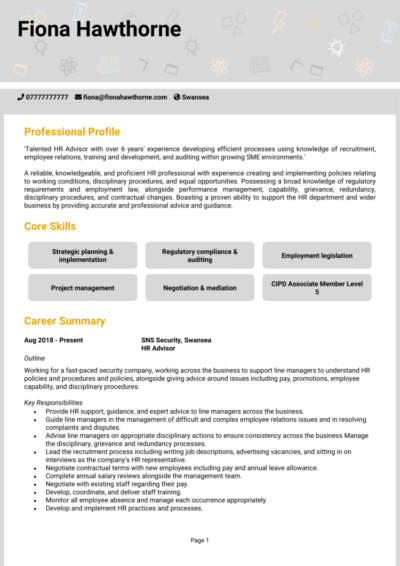As a HR Advisor, you get to support wider business goals while boosting your colleagues’ morale – all for a competitive salary.
But before you can get the job, you’ll need a CV deserving of it. This guide, complete with 3 HR Advisor CV examples, will help you craft an application that stands out and lands your next role.
HR Advisor CV example

HR Assistant CV example

HR Executive CV example

How to write your HR Advisor CV
Learn how to create your own interview-winning HR Advisor CV with this simple step-by-step guide.
This guide will take you step-by-step through writing an HR Advisor CV that highlights your expertise in employee relations, HR processes, and workplace compliance. By the end, you’ll have a CV that showcases your ability to support teams and organisations effectively.
What’s the correct structure for your HR Advisor CV?


Your CV should be as structured and professional as the policies you’ll help create. Recruiters need to quickly see your experience, your qualifications, and your strongest skills when it comes to human resources.
Here’s how to structure your HR Advisor CV:
- Name and contact details – Place these at the top for easy access. A photo is optional.
- CV profile – Begin with a concise summary that highlights your HR expertise and what you’ll br bringing to the role.
- Core skills – Focus your strongest skills that are tailored precisely to the job you’re looking for – concisely list them with some brief bullet points.
- Work experience – Provide a detailed breakdown of your work history, starting with the most recent job first. Give additional detail on the most pertinent roles.
- Education – Mention your degrees, certifications, and any training that supports your career path in the HR industry.
- Additional info – You can optionally outline the professional memberships or hobbies that emphasise your enthusiasm for the role.
Best format for a HR Advisor CV


Remember, your CV is the first impression you’ll make – ensure it reflects your expertise and professionalism. Even the most qualified candidates can be overlooked if their CV’s layout is hard to read or poorly organised.
Here’s some tips to format your HR Advisor CV effectively:
- Bullet points – These help recruiters skim through your accomplishments quickly and easily.
- Divide sections – Break your CV into distinct sections with clear headings for smooth navigation.
- Use a professional font – Stick to a clean, readable font with consistent formatting.
- No more than 2 pages – Aim for 2 pages – plenty of space to show your expertise without overwhelming the reader.
HR Advisor CV profile


Now for the first thing the recruiter is going to see when they open up your CV. The profile is a great opportunity to convince them to read more: focus on your experience and qualifications, emphasising the skills you’ve got that make you the right fit.
HR Advisor CV profile examples
Profile 1
Organised HR Advisor with five years of experience in the retail industry, specialising in employee relations, performance management, and policy implementation. Skilled in using HRIS systems like Workday to streamline processes and ensure compliance with employment laws.
Profile 2
Dedicated HR Advisor with three years of experience in the healthcare sector, focusing on recruitment, onboarding, and conflict resolution. Proficient in delivering training programmes, supporting organisational development, and maintaining accurate HR records.
Profile 3
Proficient HR Advisor with over eight years of experience in corporate environments, adept at handling disciplinary procedures, providing strategic HR advice, and fostering positive workplace cultures. Experienced in using BambooHR and SAP SuccessFactors for reporting and workforce analytics
What to include in your HR Advisor CV profile
Tailor your profile to the job description by highlighting the specific skills and experiences the employer is seeking.
Here’s what to include in your HR Advisor CV profile:
- Where you’ve worked – Mention industries or organisations you’ve supported, along with how much experience you’ve had there.
- Your top qualifications – Highlight certifications like CIPD Level 5 or degrees in HR or Business Management.
- Essential skills – Include expertise in employment law and employee relations.
- People you’ve worked with – Note the size of the team you supported, for example.
- Employee issues you’ve resolved – Reference your experience managing grievances, disputes, or disciplinary actions.
- Relevant tools you’ve used – Let the recruiter know about how well you make use of the specialist software you’d need to use.
- Processes you’ve improved – Mention any HR workflows or systems you’ve streamlined.
Core skills section


The core skills section is your opportunity to highlight the abilities that make you a standout HR Advisor. Think of it as a quick reference guide that shows recruiters you have what it takes to succeed in the role.
Top skills for your HR Advisor CV
- Employee Relations – Resolving workplace conflicts and promoting a positive working environment.
- Policy Development – Creating and implementing HR policies aligned with organisational goals.
- Compliance Knowledge – Ensuring adherence to employment laws and regulations.
- HR Software Proficiency – Managing employee records and processes using tools like Workday, BambooHR, or SAP.
- Training and Development – Organising and delivering workshops to enhance employee skills.
- Performance Management – Supporting managers with appraisals, goal-setting, and feedback processes.
- Grievance Handling – Managing complaints and disputes with fairness and professionalism.
- Recruitment Support – Assisting in hiring processes, from writing job descriptions to onboarding.
- Data Analysis – Using HR metrics to inform policy decisions and track workplace trends.
- Change Management – Supporting employees during organisational restructuring or new policy rollouts.
How to present your work experience in your CV


Your work experience section is where you demonstrate how you’ve applied your HR expertise to support teams and improve workplace processes. Focus on responsibilities and achievements that align with the job description.
List your roles in reverse chronological order, starting with your most recent position. If you’re newer to the field, include internships, volunteer work, or projects that showcase your skills.
How to structure jobs

- Outline – Provide an overview of the organisation, your role, and the HR functions you managed.
- Responsibilities – Highlight the specific tasks you performed, like handling employee disputes and conducting training sessions. Use action verbs like “implemented,” “supported,” or “resolved.”
- Achievements – Quantify your impact with metrics such as reduced grievance resolution times or improved employee satisfaction scores. Numbers always leave an impression!
Example jobs for HR Advisor
HR Advisor | Primark
Outline
Provided comprehensive HR support to a retail organisation, ensuring compliance with employment laws and fostering positive employee relations. Supported line managers in delivering HR policies effectively.
Responsibilities
- Advised managers on handling employee relations issues, including grievances and disciplinary actions.
- Monitored employee performance and supported managers with appraisal processes.
- Reviewed and updated HR policies to align with legal and organisational requirements.
- Managed recruitment processes, including drafting job descriptions and conducting interviews.
- Maintained HR records using Workday, ensuring accuracy and GDPR compliance.
Achievements
- Reduced employee turnover by 20% by improving onboarding and engagement practices.
- Streamlined disciplinary processes, reducing resolution times by 25%.
- Received positive feedback from senior management for delivering practical HR solutions.
HR Advisor | ABC Health
Outline
Supported HR operations in a healthcare organisation, focusing on recruitment, training, and employee engagement. Worked closely with management to align HR practices with operational goals.
Responsibilities
- Coordinated end-to-end recruitment processes, from advertising to onboarding.
- Delivered training sessions on workplace policies, diversity, and health and safety.
- Advised managers on handling employee conflicts and maintaining workplace harmony.
- Prepared HR reports on staff turnover, absence rates, and training completion.
- Ensured compliance with employment legislation and internal policies during audits.
Achievements
- Filled 95% of vacancies within targeted timeframes, improving service delivery.
- Implemented a staff engagement programme that increased satisfaction scores by 15%.
- Streamlined training processes, cutting administrative time by 20%.
HR Advisor | Penguin Finances
Outline
Served as an HR Advisor for a financial services firm, supporting strategic HR initiatives and operational tasks. Focused on employee relations and workforce planning.
Responsibilities
- Advised leadership on workforce planning and organisational development strategies.
- Handled complex employee relations cases, ensuring legal compliance and fair outcomes.
- Implemented new performance management frameworks to support business objectives.
- Prepared HR metrics reports using BambooHR to provide insights for decision-making.
- Supported diversity and inclusion initiatives through targeted policy updates and training.
Achievements
- Reduced absence rates by 10% through proactive engagement and wellness programmes.
- Delivered a performance improvement programme that enhanced team productivity by 18%.
- Recognised by senior management for resolving 90% of employee relations cases effectively.
Highlighting your education


The education section highlights the qualifications that support your HR expertise. Include academic degrees, certifications, and professional development courses.
For experienced candidates, keep this section brief and focus on the most relevant qualifications. Newer candidates can expand this section with coursework or projects that demonstrate transferable skills.
List qualifications in reverse chronological order, starting with the most recent.
Qualifications recruiters look for in a HR Advisor
- CIPD Level 5 Diploma in Human Resource Management – Covers HR functions, including employment law and talent management.
- Bachelor’s Degree in Human Resources or Business Management – Provides a strong academic foundation for HR roles.
- Certificate in Employment Law – Demonstrates expertise in navigating workplace regulations.
- Level 3 Certificate in People Practice – Offers training in key HR functions for junior professionals.
- HR Analytics Certification – Focuses on using data to inform HR strategy and decision-making.





